
News/Reports
Are ERs Fulfilling Their Mandate for Research and Education?
By Garry Fletcher
Presentation Outline :
When Ecological Reserves (ERs) were first being set up from 1971 on, some universities and colleges in British Columbia went to great lengths to involve their faculty and students in baseline research and ecological documentation. In this presentation, the following areas will be highlighted:
From the LOG, The Friends of Ecological Reserves Newsletter, Autumn /Winter, 2013
Currently, with the onset of changing environmental conditions, and advances in remote sensing technology, there is a strong case to be made for getting back into the field to revisit the reserves to follow up and add new benchmarks to previous baseline monitoring.
The ability of the Friends of Ecological Reserves website to reveal the history of past research and to document further research in the province’s Ecological Reserves will also be pointed out in this report.
The potential for Research in the Race Rocks Ecological Reserve will also be presented to demonstrate the accessibility for research in a marine ecological reserve where the unique situation of on-sight housing is available.
Overview of Ecological Reserves
- Ecological Reserves are permanent sanctuaries located throughout British Columbia set aside to:
- Preserve representative examples of British Columbia’s ecosystems;
- Protect rare and endangered plants and animals in their natural habitat;
- Preserve unique, rare or outstanding botanical, zoological or geological phenomena;
- Provide examples of ecosystems that have been modified by humans and offer an opportunity to study the recovery of natural ecosystems; and
- Ensure ecosystems in their natural state are available for scientific research and education.
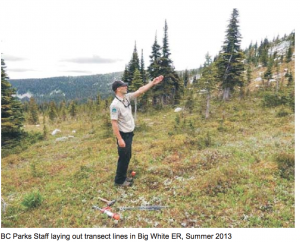 Recent Information from BC Parks Permit Office indicates that there are currently 27 active research/education permits and that doesn’t include the research being conducted by BC Parks staff, which, although not done under permit, should be added to the list.
Recent Information from BC Parks Permit Office indicates that there are currently 27 active research/education permits and that doesn’t include the research being conducted by BC Parks staff, which, although not done under permit, should be added to the list.
Long term Ecological Monitoring by BC Parks Staff began in 2011, and by 2013 there were 50 sites established.
The 2005 “State of British Columbia’s Ecological Reserves” emphasized the need for developing and implementing a baseline inventory and monitoring program for Ecological Reserves. It recommended a five-year research strategy to address key knowledge gaps related to:
- understanding threats and degradation factors and assessing their relative significance to the condition on Ecological Reserves; and
- identifying management techniques to reverse degradation and improve ecological condition.
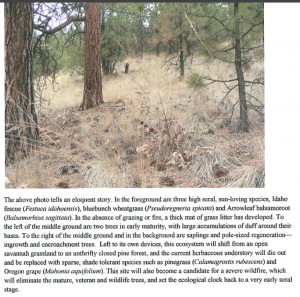 Research in Ecological Reserves
Research in Ecological Reserves
One of the major aims of the Ecological Reserve Program is to encourage the involvement of scientists in research on the reserves. To carry out research in an Ecological Reserve, a permit is required and reports are submitted to BC Parks and to Friends of Ecological Reserves for inclusion on their website.
Some examples of research reports on the FER website (available from the “Research” item in the index of the individual Ecoreserves at https://ecoreserves.bc.ca include:
- Evolutionary and Ecological Studies in Dr. Reimchen’s lab.
- Robson Bight (Michael Bigg) ER Marine Warden Program Final Report for BC Parks, 2012 and numerous Orca studies..
- Seasonal Changes in the Limnology of Some Meromictic Lakes in Southern BC.
- Checleset Bay ER Sea Otter Research by Jane Watson.
- Trout Creek ER # 7 Fire History Project: Gayton 2010
- How to manage Ponderosa Pine Ecosystems in BC’s Protected Areas by Alan Vyse.
- Species Account and Population Assessment of the Northern Pacific Rattlesnake in Canada, 2013.
Recently Ecological Reserve Warden Don Guild reported that in 2013 he helped BC Parks staff in Big White Ecological Reserve set up two transects for vegetation sampling. Most of the sampling was completed by Parks staff the same day and they went back in early August to complete the task.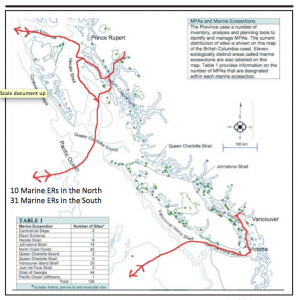
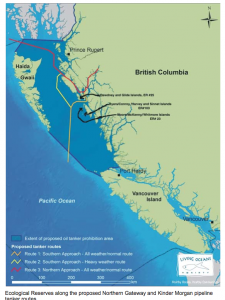 A minimum requirement for Environmental Impact research would be adequate baseline research on the Ecological Reserves along the proposed Northern Gateway and Kinder Morgan Pipeline tanker routes. So far very little, if any has been done.
A minimum requirement for Environmental Impact research would be adequate baseline research on the Ecological Reserves along the proposed Northern Gateway and Kinder Morgan Pipeline tanker routes. So far very little, if any has been done.
I recently found out that Fisheries and Oceans Canada has an Active Permit for monitoring in Rose Spit, Dewdney and Glide Islands and Vladimir Krajina Ecological Reserves.
Rich Research Potential at Race Rocks
There is rich research potential at Race Rocks ER # 97. Over the years research work has ranged from a Post-Doctorate study of Filter feeding sponges undertaken by an Israeli researcher at UVic to an introductory research paper entitled “The Ecological Niche of Anthopleura elegantissima at Race Rocks” by a Pearson College student. Links to this research is available at: https://ecoreserves.bc.ca/category/97+research/research
Several papers have been done by Dr. Anita Brinckmann-Voss on hydroids using samples collected under her permit since the 1980s. Anita has been able to identify species of hydroids, now numbering over 70. This type of taxonomic work is getting harder to accomplish as taxonomic skills are no longer a priority of many younger researchers.
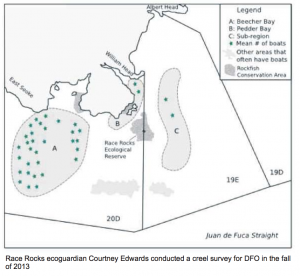 This fall, Race Rocks Ecoguardian Courtney Edwards did observations from the top of the tower as part of a DFO contract for a creel survey. Over the course of the two and a half months of single-time-point sampling, the Ecoguardians counted a total of 2,172 boats fishing within the two areas. The most boats seen fishing on a single day was 129, and with an average of 17 plus or minus 2. The most boats running on a single day was 10, with an average of 1.5, plus or minus 0.2.
This fall, Race Rocks Ecoguardian Courtney Edwards did observations from the top of the tower as part of a DFO contract for a creel survey. Over the course of the two and a half months of single-time-point sampling, the Ecoguardians counted a total of 2,172 boats fishing within the two areas. The most boats seen fishing on a single day was 129, and with an average of 17 plus or minus 2. The most boats running on a single day was 10, with an average of 1.5, plus or minus 0.2.
Gaps in Research at Race Rocks ER
There are, however, gaps in research at Race Rocks ER:
- Since the area is a Rockfish Conservation area, research should be done on population levels of fish species in the area.
- Since almost every phylum of invertebrate is there and accessible by diving, ecological and behavioural studies in situ are possible, as well as biogenetic studies.
- The large population of californianus mussels could provide samples for the testing of the presence of a wide range of human-generated chemicals.
- Plankton studies, especially with underwater monitoring of daily fluctuations and primary productivity investigations could be done at Race Rocks.
- Instrumentation for Chlorophyll studies in conjunction with ground-truthing for satellite productivity in the Strait of Juan de Fuca.
- The upper tide pools have always been excellent sources of Pyramimonas sp flagellates. The distribution of this species is probably rather restricted along the coast of British Columbia. In this location, the organisms are available in the guano-nourished upper tide pools for much of the year.
- Ocean acidification should be monitored for baseline and long term results.
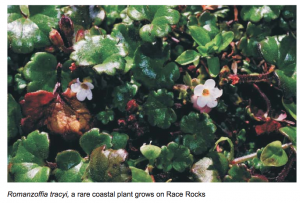 Many more research ideas could be entertained. There is easy access to many opportunities for research on macroalgae and plankton communities. Romanzoffia tracyi, a rare coastal plant grows in several patches on the island.
Many more research ideas could be entertained. There is easy access to many opportunities for research on macroalgae and plankton communities. Romanzoffia tracyi, a rare coastal plant grows in several patches on the island.
There are potential marine mammal studies that could be done as there are resident harbor seals (birth colony), elephant seals (birth colony), California sea lion, Northern sea lion and river otters present. There are also occasional sightings of porpoise species, Orcas, humpback whales, gray whales and the first sea otters have shown up in the last two years.
There are opportunities to study resident nesting birds, such as Pigeon Guillemots, Glaucous-winged Gulls and Pelagic Cormorants on Race Rocks. During the winter months, Race Rocks’ resident birds include Black Turnstones, Savannah Sparrows, Brandt’s Cormorants, Pelagic Cormorants, Double-crested Cormorants and Black Oystercatchers. Peregrine Falcons, Bald Eagles and Red-tailed hawks are also found on the islands.
Fish species could be included in studies. Many sculpin species, wolf eels, rockfish species, salmon, ling cod, kelp greenling, cabezon, gunnel and three cartilaginous species have been photographed in the waters off Race Rocks. At least eight species of Tunicates have been recorded and photographed.
In 2000 as a member of DFO’s Marine Protected Areas (MPA) Advisory Board, I proposed buffer zones for the MPA. They were not accepted partly because of objections from the Sport’s Fishing community. Benefits however for fish enhancement, could be considerable. Adequate research was not available to show that possibility.
What is Involved in Doing Research at Race Rocks?
Lester Pearson College maintains the facilities at Race Rocks under a long-term lease arrangement with BC Parks. It is one of the few ERs with housing available to researchers.
The Marine Science Centre residence is the building that formerly housed the assistant light-keeper at Race Rocks. It is equipped with a kitchen, including fridge, stove and basic eating and cooking utensils, as well as internet access, and can accommodate six researchers. Visitors supply their own linens and food. Requests for use of the facilities must be accompanied by a proposal to Pearson College outlining the purpose of the visit. For researchers, there is a $30 fee per person per night.
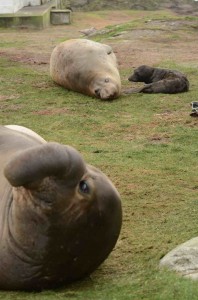
Male elephant seal in foreground, with female and pup in the background. The pup was born at race Rocks, January 14, 2014. (Photo by Alex Fletcher)
If SCUBA diving is needed for research, arrangements may be made with the Director of Operations for Race Rocks. Special safety precautions will be required as it is a high current area. A boat tender must be available for emergency pick up. More information about Permits and arrangements for transportation and housing can be obtained by contacting Chris Blondeau at Lester Pearson College, 250-391-2411.
Permitting Process
As the Ministry of Environment benefits from the free science information that researchers bring, FER feels that the current permitting process needs to be reviewed and significantly improved in order to provide better service to the research community. There is no application fee or any other permit fees charged for ecological research in parks and protected areas as research is deemed to be a public good. However, there is a 60 day turn around period expected on Education and Research Permit applications, but that is flexible and according to the permitting office. The onus is on Parks Area Supervisors to get them approved. By comparison, the Ministry of Forests, Lands and Resource Operations staff must process small scale salvage permits and approve or deny a permit request within two days of receiving it.
If MOE and FER are to attract researchers and their funding, the current process is too protracted in our opinion.
Application Review Process
The proposed activities are assessed by regional staff to ensure that they are consistent with the purpose for which the ER was established. Then BC Parks staff conducts an impact assessment using the established process (see http://www.env.gov.bc.ca/bcparks/conserve/impact/impact.html to determine if there are any social, cultural or ecological impacts associated with the proposed research activities.
If the activities are deemed suitable, BC Parks staff then consults with First Nations and/or other stakeholders. In some cases, this may involve coordinating with other jurisdictions or with other regions, particularly when the proposed research activities take place over a larger geographic scale. Once a complete application is received, BC Parks strives to process, adjudicate, and issue an Ecological Reserve permit in 60 business days.
To view the complete presentation see:
